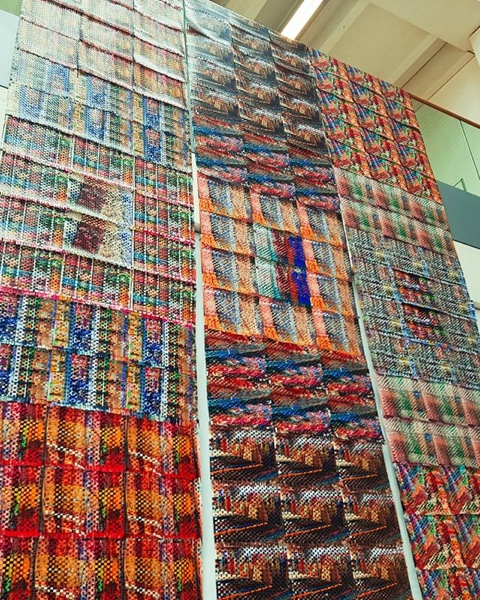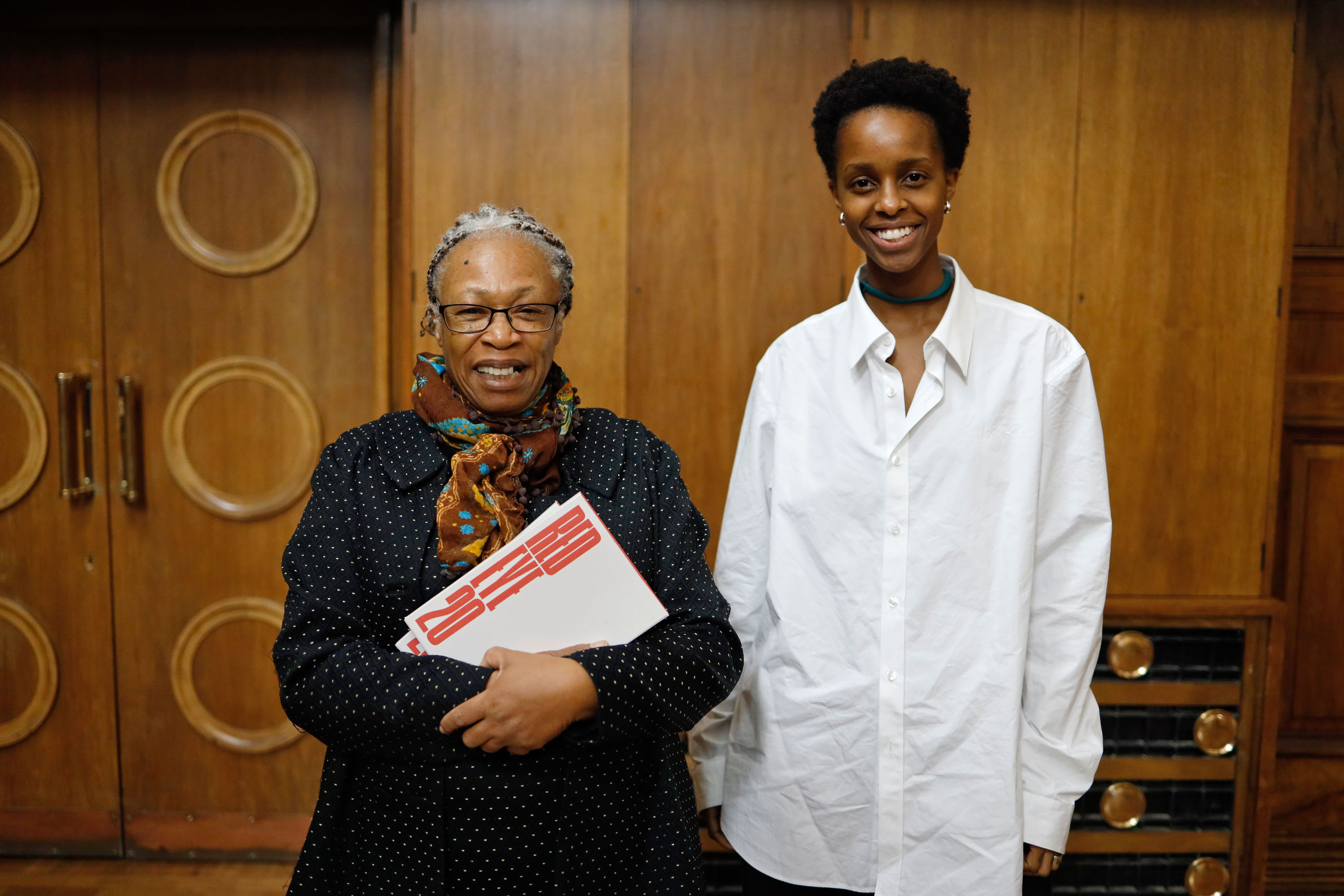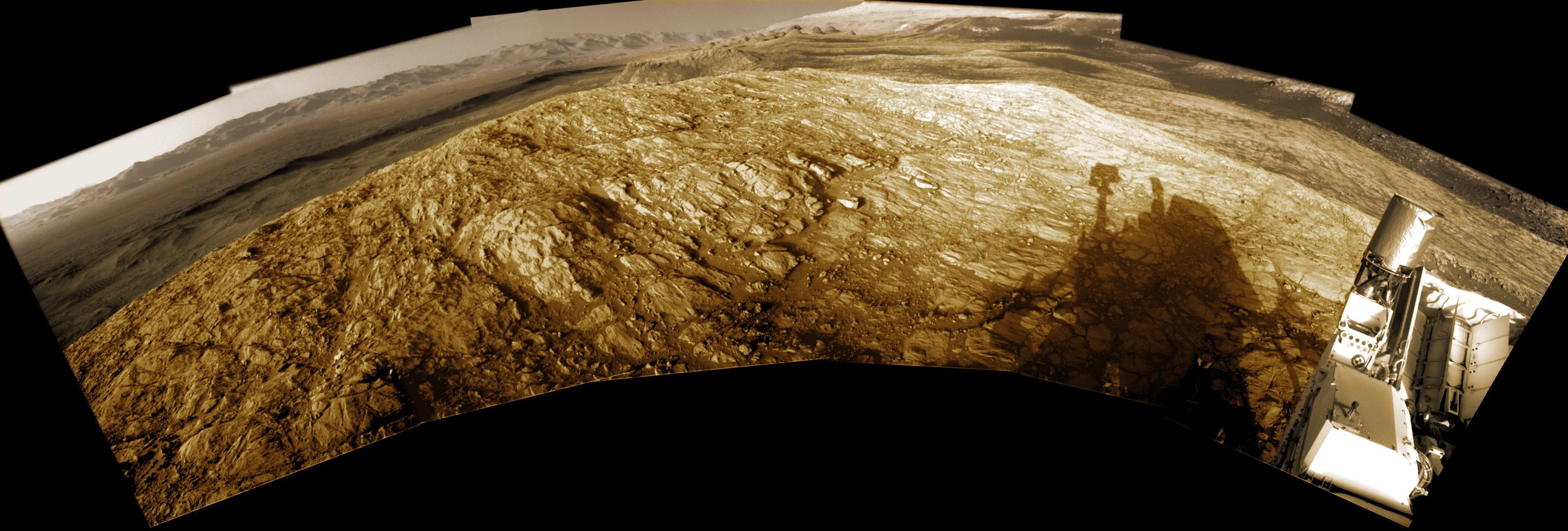
As 2019 comes to a close, we here at Redeye and PCN have been discussing the events and exhibitions that stood out across the year. Many of the exhibitions are showing into 2020 if you are looking for suggestions. Here are the picks:
Rachael Burns, programme coordinator at Redeye
My exhibition of the year is Nilupa Yasmin’s By the Metre at The Herbert Art Gallery in Coventry. Commissioned by Photo Archive Miners, A Tale of Two Streets was a project investigating two of Coventry’s most notable streets. Paying homage to Foleshill Road, an area formerly densely populated with factories, Nilupa created a 28ft installation of woven photographs.
Through the painstaking process of weaving together her images from Foleshill Road, Nilupa created a vibrant and immersive installation that celebrates Coventry’s history of craftsmanship. At first look the piece almost resembled an abstract tapestry, giving way to more colour and pattern the closer you look before giving tiny photographic details of the shops that now populate Foleshill Road. For an area that was once home to ribbon weaving factories, By the Metre was a perfect tribute to honour Coventry’s past and present.
Nilupa Yasmin is an artist based in the Midlands, who investigates her South Asian heritage through photographic work about culture, self-identity and anthropology. If you would like to see more of Nilupa’s work she is currently exhibiting at New Art Gallery Walsall in Too Rich a Soil with Arpita Shah and Maryam Wahid. The exhibition continues until 19 April 2020.

An exhibit from Nilupa Yasmin's "By the Metre", Exhibited at The Herbert Art Gallery and Museum, 2019.
Debbie Cooper, manager of the Photographic Collections Network
Exhibitions:
White Heat of British industry, 1950s-60s: photographs by Maurice Broomfield. FORMAT International Photography Festival featured photos from the V&A collection curated by Martin Barnes. I had not seen Maurice Broomfield's work before this exhibition; I was blown away by this 1950s fashion editorial aesthetic used in industrial factory settings.
Scotland's Photograph album, Images from The MacKinnon Collection, featuring top photographers of the late 1800s early 1900s, currently exhibited at National Galleries Scotland and National Library Scotland (this was also a featured collection on UKPCN twitter).
Oscar Marzaroli, Street Level Photoworks, Glasgow. Stunning exhibition of photographs and films of Glasgow from the 1950s through to the 1980s, coinciding with his collection being moved to Glasgow Caledonian University (continues until 15 March 2020).
Collections:
The Photographic Collections Network works with public and private collections across all of the UK. We've seen so many fantastic collections this year, it's really hard to choose any favourites - but if I'm pushed to choose my top ones would be:
Madame Tussauds Collection, featured on the PCN website with a fantastic write up from Tussauds Curator Zoe Louca-Richards.
Twitter weekly featured collections: every week on twitter PCN features a UK based photo collection or archive, some of my favourites are:
Birmingham Museums Image Library (see tweet). I was surprised to see photographs of Pre-Raphaelite Muse, Jane Morris; after studying the Pre-Raphaelite paintings at art school it was great to see the photographs alongside the paintings.
Visualising China, Historical Photographs of China (HPC), more than 20,000 digitised images of photographs of China taken between 1850 and 1950, scanned from family photo albums. Video about the project here.
National Cycle Archive, Warwick Library. Vast archive which includes scanned journals of cycling trips around Britain and Europe; my favourite album is this of Joseph Hall, featuring photographs, diary entries and sketches from his cycle journey in 1898.
Conferences:
Grain, State of Photography Symposium
Institutional Lives of Photographs, V&A
Blog posts:
Electrifying Daguerrotypes, blog post from Rachel Nordstrom Special Collections of the University of St Andrews on conservation and repair of daguerrotypes
New mobile experiences of vision and modern subjectivities in Late Victorian Britain, Science Museum Group Journal, article looking at relationship between photographing and cycling in Late Victorian Britain by Sara Dominici.
Paul Herrmann, director of Redeye and of the Photographic Collections Network.
2019 was quite a year. Although public organisations were feeling the pinch, there seem to have been more good photography exhibitions and events than ever.
Exhibitions:
Three shows making up the photography season at National Museum Cardiff, in particular Bernd and Hilla Becher and August Sander, run until 1 March 2020, along with Martin Parr until 4 May 2020. At the launch it was a treat to hear from Bernd and Hilla’s son Max who explained their partnership better than anyone I’ve heard; and recalled some of the unconventional methods his parents employed to be sure of getting the right photo.
LOOK Photo Biennial was tighter than ever, in particular Peer to Peer at Open Eye Gallery and St Georges Hall, Liverpool (see below), along with an appealing “satellite” programme. Another strong and unusual exhibition at Open Eye Gallery was 209 Women: all the UK female Members of Parliament each photographed by a different female photographer. In many cases these are MPs as you have never seen them, and in a sense a rational response to some of the year’s political bunfighting.
Seaside Photographed, a huge show curated by Val Williams at the Turner Contemporary in Margate, seemed to get more and more compelling and unexpected the deeper you got into the exhibition.
I really liked the way that the Imperial War Museum North publicised Yemen: Inside a Crisis – madly overpriced vending machines on Piccadilly station, and other pop-up interactive experiences in the city, designed to give a sense of what life is like inside this terrible conflict. On until 26 Jan 2020.
It’s great that Sale Waterside is paying more attention to photography; in April they opened a rich show of contemporary work, Sweet Debris, featuring the work of Chris Rhodes, Phoebe Kiely, Theo Simpson and Hannah Farrell, all focused on finding meaning and beauty amongst the detritus of modern life. Hopefully a sign of more to come. https://www.youtube.com/watch?v=37eusB5Ez0s
A new, smart and very welcome photography space opened at the Royal Photographic Society in Bristol. They’ve already had some excellent exhibitions with wide appeal – I enjoyed the trip down memory lane commemorating the 50th anniversary of the moon landings. rps.org
Two exhibitions where both text and photographs were essential components: Loved and Lost by Simon Bray at Manchester Cathedral was a powerful exploration of the death of a loved one. A new version of this exhibition can be seen until April 2020 at Weston Park Museum, Sheffield.
Meanwhile Sixteen is an object lesson in how to set up and tour a big group photographic project. A fascinating piece of primary research on what it is to be 16 in 2019, dreamt up by Craig Easton. Carries on into 2020, and well worth a visit.
My two favourite exhibitions of the year both captured aspects of conflict, but very differently:
Borderland: Stories from Donbas is the first major solo show by photographer Christopher Nunn. It explores an area on the eastern edge of Ukraine, in Europe’s only active war zone. Christopher first travelled there six years ago in search of his family history, and was there a year later when the unrest and conflict began. He has made a powerful and moving record of everyday life in the region. You can still catch this exhibition at Impressions, Bradford until 4 Jan 2020.
Red Saunders is a photographer who thinks on an epic scale and in many ways his exhibition recreating the Peterloo Massacre 200 years after it happened is one of the highlights of his career. His method involves photographing multiple details from a re-enaction of an event and then piece them together digitally. But that description hardly does justice to the huge and stirring images he creates. They were squeezed into the gallery at Manchester Central Library just metres from the site of the massacre.
Events:
I’m not sure if there are more photography events, talks, conferences, fairs and festivals in the UK than ever - it certainly feels that way and in fact one weekend in October featured FIVE simultaneous photo festivals in the UK.
We ran dozens of memorable events at Redeye and the Photographic Collections Network. Probably the ones I will remember most are the talks we arranged for Redeye’s 20th birthday. We invited three of the first ever speakers at Redeye in 1999 – Joy Gregory, Simon Norfolk and Paul Hill – to come back 20 years later, each bringing with them a rising star of photography. So we were witness to fascinating insiders’ dialogue about how the profession has changed, and remained the same, over the past 20 years. It’s clear that with photographers like Yan Wang Preston, David Grinly and Ronan McKenzie (pictured below right, with Joy Gregory on left), the future of creative photography is in safe hands.

Joy Gregory and Ronan McKenzie at Sale Waterside for Redeye, October 2019.
Helena Lee, administrator for Redeye
I recently visited Peer to Peer, a group show of 14 artists from the UK and China, covering a wide breadth of themes. I was particularly interested in five works that combine two of my passions; nature and photography. At Open Eye Gallery, Anna Ridler’s Mosaic Virus is a visually attractive and technically compelling piece exploring tulips as a commodity. Linking what is considered the first recorded financial bubble, Tulip-mania, to the current crypto-currency Bitcoin, Ridler’s installation is a projection of thousands of tulips that bloom and wither in accordance with the rise and fall of the value of Bitcoin. Clever and beautiful at the same time.
As you enter St.George’s Hall, you are immediately faced with Fan Xi’s Tree, a series of composite images made from photos of hundreds of trees from different angles. The result is convincing portraits of single trees that feel somehow without context, I guess the appropriate phrase would be rootless… The images suggest tree ideals, yet knowing that they don’t exist as they are presented in real life opens up questions about human intervention and control of nature.
Another series that explores this subject is Yan Wang Preston’s Excerpts from Forest. In this case, rather than the photographer manipulating the image, these are landscape photographs documenting a current process by developers in China to manipulate nature in order to make it look and feel ‘natural’. Preston charts journeys of mature trees that have been uprooted from their natural habitat and re-located to different parts of the country with different environmental conditions, all carried out under the banner of beautification.
Maisie Cousins’ Rubbish series comprises blown-up images of kitchen waste; including moulding and decaying food and plants, plastic bags and packaging. The images are colourful, textured and abstracted to make superficially attractive compositions; it’s the subject matter that is repulsive. Yet, to me it suggests the power of nature to recover and restore despite humans’ wasteful consumptions.
Finally, Mandy Barker’s series Soup is the most direct and deliberate comment on the climate crisis, asking us to face up to the impact of human consumption on our natural world. Like all of the photographs in this exhibition, the viewer is initially attracted by the beauty of the image, drawing us in. When we are up close, the message becomes personal and clear as what looked like pretty, colourful compositions are carefully composed arrangements of plastic objects that have been washed up on beaches around the world.
Peer to Peer at Open Eye Gallery and St. George’s Hall, Liverpool until 22 December 2019.
Laura Winters, interim marketing manager at Redeye
Working remotely, I often find myself a little frustrated that I'm not able to make it to the events I'm writing into the Redeye newsletter or booking people tickets for. However, the Internet has risen in prominence as a medium for exhibiting photographs, so distance or health issues no longer need to isolate people from culture. If anything, the biggest problem is one of overabundance; there's now so much content available (and indeed, generated on a daily basis), that sifting through it is a difficult task.
I was pleased to recently see that Astronomy Picture of the Day is still going now, some 20 years after I had it set as my browser homepage. With no changes to the format in over two decades, it's quite a nostalgic experience to visit, despite the futuristic feel of the content.
Wildlife Photographer of the Year, founded in 1965, is an annual competition run by the National History Museum, London. For the last decade, award winning photographs have been showcased on their website.
And if you prefer a sillier version of the above, there is the Comedy Wildlife Photography Awards.
The Photographic Collection Network's "featured collections" have been a nice spotlight on facets of a broad spectrum of photography. Many of these have been accompanied by a blog post which dives into a little more detail about the collection.

Late afternoon on Mars, by NASA, JPL-Caltech, Marco Di Lorenzo
Top image: Laura Winters